
* The Harrier emerged from the P.1127 / Kestrel by a complicated and more-or-less lucky sequence of events. The aircraft that resulted, though suffering from a number of limitations in performance, range, and warload, proved extremely useful, and became an important front-line asset for both the RAF and the US Marine Corps (USMC).
Another complicated and more-or-less lucky sequence of events led to the modification of the RAF Harrier for Royal Navy use as the "Sea Harrier", which proved critical to British victory in the Falklands War in 1982, and which was given major extensions in capability after the war. This chapter outlines the development and careers of the "first-generation Harriers".
* Hawker's John Fozzard was put in charge of the development of the Harrier GR.1. While the new aircraft was derived from the Kestrel and unmistakeably resembled it, in engineering terms the Harrier GR.1 was a complete redesign, with only about 7% of its engineering drawings identical to those used for the Kestrel. One of the two Kestrels retained by the UK was used for engine development trials.
Initial flight of the Harrier GR.1 was on 31 August 1966. Six preproduction aircraft were built, which were all used for test and evaluation and never entered operational service. The first production Harrier GR.1 was flown on 28 December 1967. It began its military career almost exactly a year later, on 1 January 1969, with the Harrier Conversion Team formed at Wittering, and was fielded with RAF Number 1 Squadron in October of that year in the attack role. Unfortunately, Sydney Camm had died on a golf course in 1966, and never saw the Harrier in operation.
The Harrier was a unique aircraft that offered capabilities and challenges no combat pilot had ever been given before, and so a two-seat conversion trainer version, the "Harrier T Mark 2", was ordered in 1967 in order to assist new pilots in adjusting to the type.
* The GR.1 and T.2 provide a baseline configuration for later Harriers. Both aircraft were powered by the "Pegasus 6 Mark 101" engine, with 84.6 kN (8,620 kgp / 19,000 lbf) thrust. Water injection provided incremental boost thrust over the Kestrel's Pegasus 5. Very importantly, the Pegasus 6 was much more reliable than the Pegasus 5, with an operating time between overhauls of 300 hours, as opposed to only 50 hours for the Pegasus 5.
The general configuration of the Harrier was a directed evolution of that of the P.1127 and Kestrel. As noted, the Pegasus engine had to be placed at the center of gravity, and the wing had to be raised high to clear the four rotating exhausts, leading to the bicycle-style tandem landing gear. For low-speed flight, engine bleed air was routed to puffers in the nose, tail, and wingtips to allow maneuvering, and the forward fan and compressor spool in the Pegasus contra-rotated to nullify the effects of angular momentum that could make such maneuvers more difficult.
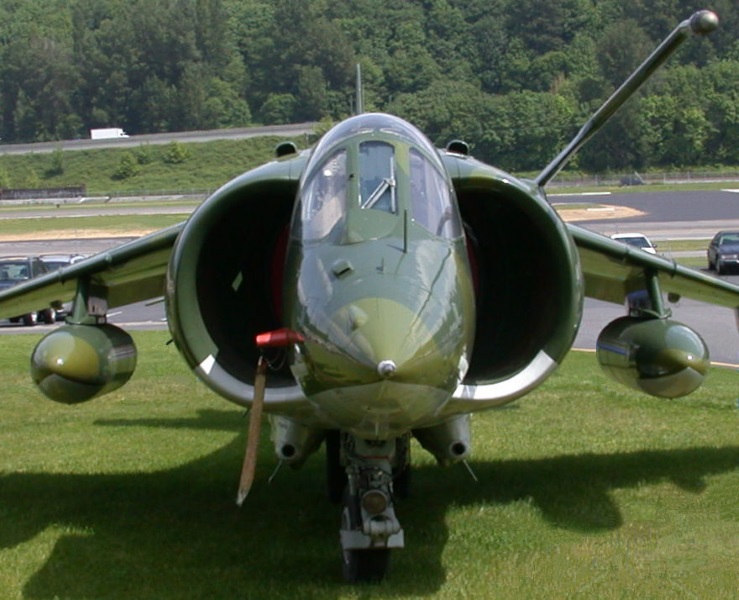
The Harrier had the big "elephant ears" intakes to feed the forward fan, with the cockpit squeezed in between them. There were eight small doors around each intake to allow greater air input when required. The big intake hid the four rotating exhaust nozzles from the airstream.
Although Hawker engineers had been puzzled on how to arrange the cockpit controls for VTOL flight when they first began work on the P.1127, their experiments resulted in a simple and logical, if not very convenient, scheme. The cockpit layout provided the pilot with three levers on his left, from farthest to nearest:
Adjusting the nozzle angle lever moved the four nozzles in unison, directed by a yoke under the Pegasus engine and rotated via a chain drive by a motor operating off engine bleed air.
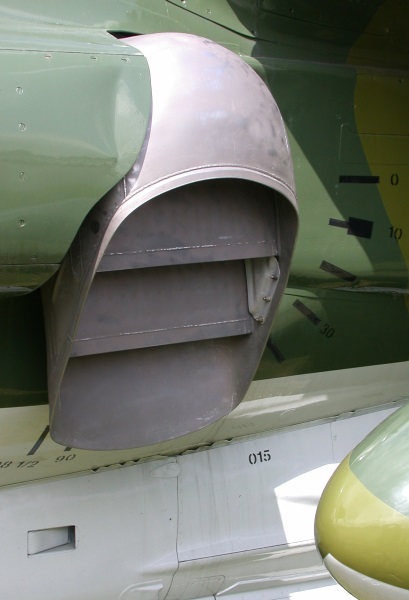
The GR.1's wing was entirely new. It was optimized for subsonic flight, with maximum rated speed of 1,185 KPH (736 MPH). The wing was small, in order to reduce buffeting in low-level operations, with an area of 18.67 square meters (201 square feet). The wing was built as a single piece and had to be removed for an engine change. Optional "ferry tips", each 69 centimeters (27.2 inches) long, could be attached to the wing tips to provide about a 9% increase in range, at the expense of speed. A midair refueling probe could also be bolted on to the left side of the aircraft, just behind the intake, for ferry flights. The tail was conventional, similar to that of the Hawker Hunter, but included a small ventral fin, featuring a bumper to protect the aircraft in a rough landing. The pop-up ram-air turbine emergency power generator system in front of the tail that had been introduced with the P.1127 was retained.
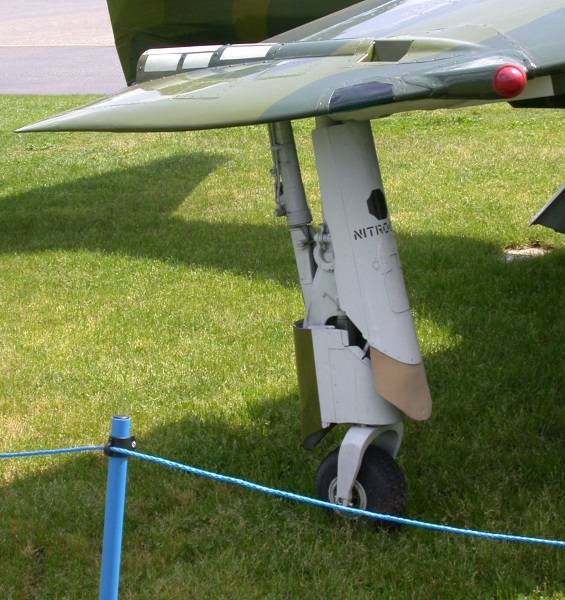
The flight control system was based on a traditional wheel-and-pulley scheme, with an interesting variation in that the tail (yaw) and wingtip (roll) thrusters for hovering flight were slaved to the appropriate control surfaces. There was also a pitch thruster in the nose. The pilot controlled the thrusters in exactly the same way that he controlled the normal flight control surfaces. The thrusters were activated when the nozzles were moved 20 degrees down from the horizontal, and were driven by engine bleed pressure of up to about 12 atmospheres at 400 degrees Celsius, resulting in a thruster exhaust velocity of over 2,700 KPH (1,680 MPH)!
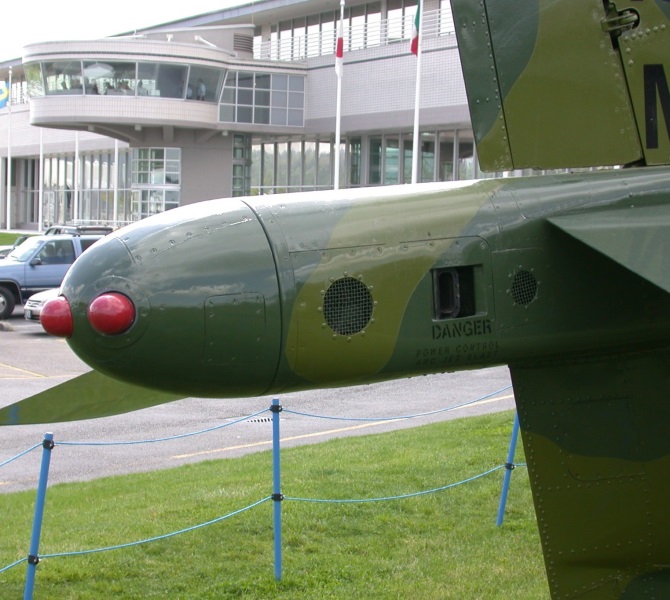
The GR.1's cockpit was somewhat cramped and squeezed between the two big intakes, resulting in no rearward visibility. It was also said to be very noisy, pilots claiming it seemed the engine was actually in the cockpit with them. The GR.1's flight avionics were simple, consisting of:
No radar was fitted, having been judged unnecessary for the daylight close air support role. The GR.1 also had an interesting feature useful for low-speed hovering flight: a little "weathervane" in front of the canopy that served as a yaw sensor. The windscreen was "hardened" to resist birdstrikes, a serious threat in low-level operations. The windscreen could withstand the impact of a 4.5-kilogram (11-pound) bird at an impact velocity of 1,100 KPH (680 MPH).
The GR.1 was fitted with a Martin Baker Mark 9 rocket-boosted "zero-zero" (zero speed, zero altitude) ejection seat. Instead of blasting off the canopy, the GR.1 had a string of "miniature detonating cord (MDC)" ribboned around the top of the canopy. Before ejecting, the detcord would blast the top of the canopy into fragments, and the pilot would eject through the hole. Although this is a fairly common measure now, the Harrier was one of the first aircraft to incorporate the scheme because, in hovering mode, blasting off the canopy would have thrown it straight up, and the ejecting pilot couldn't miss it.
The GR.1 had five stores pylons, one under the fuselage and two under each wing. Typical external warload was about 2,270 kilograms (5,000 pounds) and could include:
Two Aden Mark 4 30-millimeter revolver-type cannon pods could be attached to the belly. Each cannon carried 100 rounds and had a rate of fire of about 1,200 rounds per minute. The gun pods also helped improve hovering characteristics by trapping backblast when in ground effect; and reduced exhaust-to-intake gas ingestion problems, a common difficulty with VTOL jets. If the pods were removed, a pair of strakes were installed in their place to maintain hovering flight characteristics.
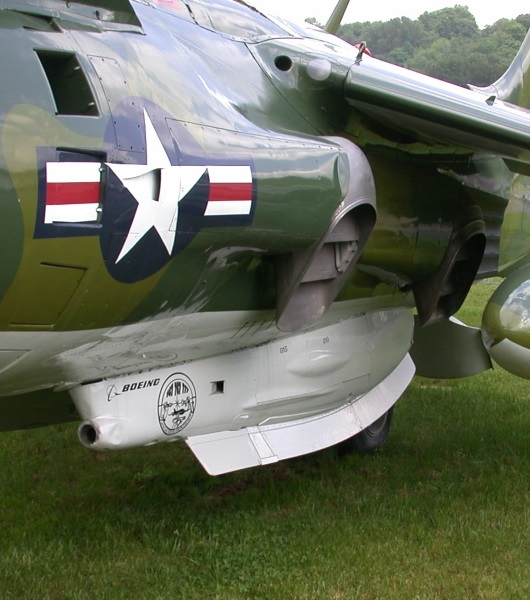
* The first of two T.2 prototypes performed its initial flight in 1969. The T.2 featured a stretched fuselage to accommodate the two seats in a tandem fashion. The stepped-up canopy was hinged on the side, not backwards-sliding as with the GR.1, and the back seat was stepped up to give the instructor an excellent forward field of view. To compensate for the extended nose the tail was also extended, and both the tailfin and ventral fins were increased in size. The T.2 was completely combat-capable, able to carry a full load of fuel and weapons.
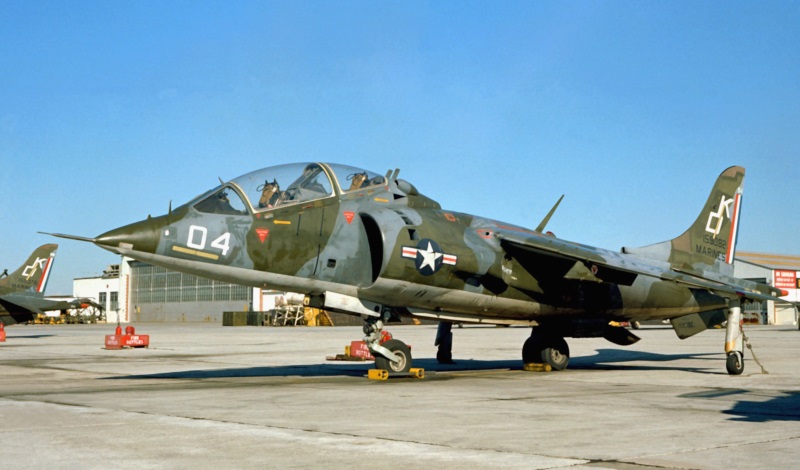
The Harrier was not truly a VTOL aircraft; a GR.1 couldn't take off vertically with a full combat load. In practice, the nozzles were angled down to about 55 degrees below level, and the aircraft would blast off after an astonishingly short take-off run. It would be more appropriate to call the machine a "short take-off / vertical landing (STOVL)" aircraft. Actually, although landings could be performed vertically if stores had been expended, Harrier pilots often preferred a short landing roll. This was a useful practice in field environments since it avoided sucking dust and debris into the engine. On a rolling landing, the nozzles could be pointed 8.5 degrees forward of vertical to reduce landing roll. That also allowed the aircraft to be flown backward, though that was almost never done as anything but an airshow stunt.
Pilots found the aircraft generally straightforward to fly once in normal flight, but take-offs and landings could be tricky and dangerous. Having to deal with the stick, throttle, and nozzle angle lever required "three hands", increasing pilot workload on take-offs when the workload is maximized in the first place. The first person killed in Harrier, USAF Major Charles R. Roberg, died in 1970 when he tried to turn during the transition period and went out of control. There would be a fairly large attrition among Harriers in operation, but that would also be due to the demanding nature of low-level operations. The Harrier was not regarded as "bad" aircraft, just a "unique" one because of its unique capabilities; it was generally flown by the most experienced pilots who were given extensive training to convert to the type.
Combat radius of the GR.1 was about 370 kilometers. That was only about half the range of a Jaguar strike fighter but was regarded as acceptable, since the aircraft was intended to be based near forward combat areas to provide quick-response strikes. A total of 61 GR.1s and 10 T.2s was built, not counting the two T.2 prototypes and a single "Mark 52" two-seat Harrier, which had the tailcode "G-VTOL"; it was retained by Hawker Siddeley for test purposes.
BACK_TO_TOP* Further tweaking of the Pegasus engine resulted, in 1969, in the "Pegasus 10 Mark 102", with 91.2 kN (9,300 kgp / 20,500 lbf) thrust, as compared with the 81.0 kN (8,620 kgp / 19,000 lbf) thrust of the Pegasus 6 Mark 101. Harriers produced with the new engine were "GR.1As", with 17 built, and "T.2As", with four built. Surviving GR.1s and T.2s were re-engined to the GR.1A and T2.A specification.
Pegasus development didn't stop there. The next major revision was the definitive "Pegasus 11 Mark 103", which provided 95.6 kN (9,750 kgp / 21,500 lbf) thrust with a modified fan, combustion chamber, fuel control system, and higher operating temperature. A new Pegasus variant led to a new Harrier variant, the "GR.3", which incorporated some avionics upgrades. There was also a corresponding trainer version, the "T.4". A total of 40 GR.3s new-build GR.3s was manufactured, as well as 11 T.4s.
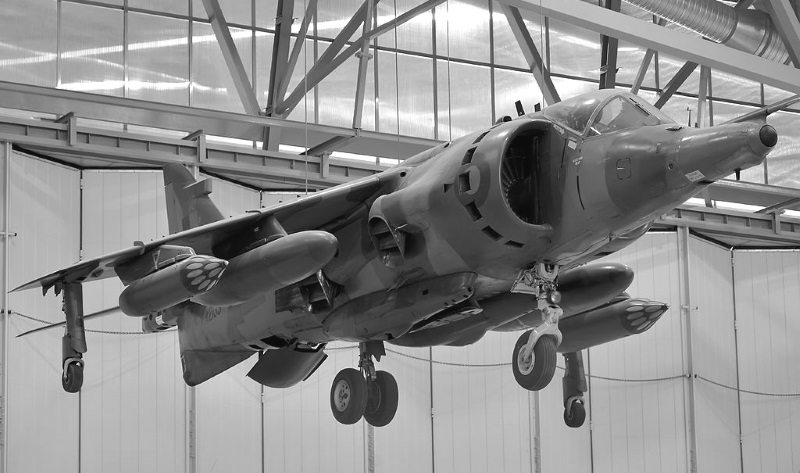
The most visible change to the GR.3 relative to the GR.1 was the addition of an elongated nose "thimble", to house a Ferranti 106 "laser ranger & marked target seeker (LRMTS)". This instrument could either be locked onto a target to provide continuous updates on position and rate of closure via laser rangefinder, with the result displayed on the cockpit HUD; or could be used as what is now known as a "laser spot tracker", locking onto a target being illuminated by ground troops or whoever with a laser target designator.
The LRMTS gave the GR.3 a "Pinnochio nose", or as the RAF called it, a "Snoopy nose", appearance, after the famous long-nosed beagle in the globally popular American PEANUTS comic strip. The nose did not affect the aircraft's flight characteristics, and so no aerodynamic adjustments were required to the airframe. The LRMTS was also refitted to older GR.1As still in service. In addition, the GR.3s were fitted with a camera shooting out the left side to give them a basic reconnaissance capability. Another visible change was a Marconi ARI-18223 radar warning receiver (RWR), whose forward aerial appeared as a tab breaking up the smooth forward curve of the tailfin. The rearward aerial was placed less obtrusively on the tailcone. The new avionics demanded more electrical power, and so the twin 4 kVA alternators of earlier Harriers were replaced by a single 12 kVA alternator.
___________________________________________________________________
HAWKER HARRIER GR.3:
___________________________________________________________________
wingspan:
7.7 meters (25 feet 3 inches)
wing area:
18.67 sq_meters (201 sq_feet)
length:
14.27 meters (46 feet 10 inches)
height:
3.63 meters (11 feet 11 inches)
empty weight:
6,140 kilograms (13,535 pounds)
loaded weight:
11,430 kilograms (25,200 pounds)
max speed, low level:
1,175 KPH (730 MPH / 635 KT)
service ceiling:
16,800 meters (55,000 feet)
combat radius:
670 kilometers (415 MI / 360 NMI)
___________________________________________________________________
The T.4 featured similar kit, including the LRMTS.
* Four RAF squadrons and an operational conversion unit (OCU) were equipped with the Harrier. Number 1 Squadron was based at RAF Wittering in the UK, along with the OCU. Three squadrons -- Number 3, 4, and 20 -- were set up at Wildenrath, Germany, near the Dutch border, in 1970 and 1971. In 1977, Number 20 Squadron was disbanded and its aircraft absorbed into its two sister squadrons. These two squadrons were moved to RAF Guetersloh, east of the Rhine.
The primary mission of the RAF Harrier was to provide combat support for British I Corps Germany. In tactical exercises, the Harrier squadrons broke into three flights each and dispersed to the countryside, where they went into hiding among the trees under camouflage nets, with rubberized fuel storage tanks set up some distance away. Take-offs were performed on a 180-meter (590-foot) stretch of aluminum planking, though in actual combat operations any reasonable roadway would have done just as well. From these hidden forward sites, pilots remained on station in the cockpit to await a call for fire support from a forward air controller through a "Forward Wing Operations Centre". Typically the Harriers would take 20 minutes to perform the strike and then, munitions expended, return to their base site to refuel and re-arm. A Harrier pilot could easily fly six sorties in a single day.
* In the mid-1970s, Guatemala began to threaten the neighboring Central-American country of Belize, which had formerly been the colony of British Honduras. Since Belize had only one runway capable of supporting most combat jets, and since in any conflict that runway would be an excellent target, six Harriers from Number 1 Squadron were transported to Belize and established as RAF Number 1417 Flight as a permanent presence.
In the spring of 1977, Hawker Siddeley was absorbed into the initially nationalized British Aerospace (BAE) group, and the "Hawker Siddeley Harrier" then became the "BAE Harrier".
BACK_TO_TOP* Although the US Marine Corps had a strong interest in VTOL aircraft, as noted, the USMC did not participate in the Tripartite Evaluation Squadron. However, when the US took ownership of six Kestrels from the TES, some of them also ended up at the Naval Air Test Center at Patuxent River, Maryland, where the Marines performed flight evaluations with them. In April 1966, the Marines operated a Kestrel off the commando assault ship RALEIGH and were impressed with the aircraft. The exercise was strictly a demonstration: the Kestrel had no combat capability and was useless to the Marines as it was, and there matters stood until the Farnborough Air Show in the UK in September 1968.
Two USMC officers attended the Farnborough show at the invitation of Hawker Siddeley, and were given flights in the Harrier. They felt the Harrier was what they were looking for. What the Marines required was a strike aircraft that could support landing forces. Fleet carriers had to be kept well at sea for their own safety, but Harriers could fly from smaller assault ships just offshore, or from rough landing sites behind the battle lines, to provide quick-response strikes for ground troops.
The main obstacle was that the Harrier was a British machine, and the US armed forces traditionally had a strong preference to "buy American". The solution was for Hawker Siddeley to license the aircraft to McDonnell Douglas (MDD) for sale to the USMC "AV-8A". Rolls-Royce, which had bought out Bristol in the interim, similarly made an arrangement to allow Pratt & Whitney (P&W) to build the Pegasus under license, which then became a P&W "F402-RR". These collaborations were to be crucial to the future of the Harrier.
In practice, although the original agreement envisioned that MDD would actually build Harriers themselves, the AV-8As, or "Mark 50 Harriers" as Hawker designated them, were not actually made in the US, since opening a second assembly line was judged uneconomical. They were built in the UK, shipped as airfreight overseas, and delivered by MDD, with MDD presumably performing final fit of USMC-specific kit. The first few AV-8As used the Pegasus 10, but all following production used the Pegasus 11.
The Marines traditionally worked through US Naval Air Systems Command for their aircraft acquisitions -- but the Navy had no interest in the Harrier. Some Marine Harrier enthusiasts judged NAVAIR was downright hostile to the Harrier; that may have been over-reacting, but the bottom line was that the Marines were on their own with the Harrier, having to perform their own evaluation, training, and doctrine development. The British performed training initially.
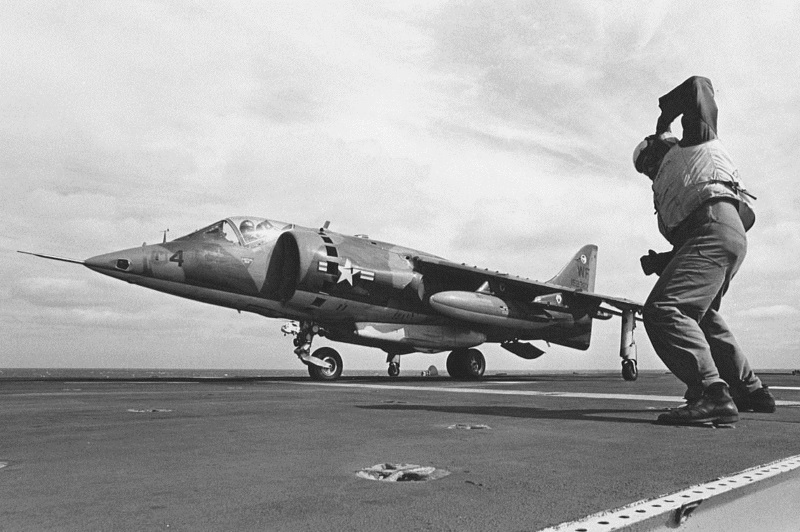
102 AV-8As and 8 "TAV-8A" or "Mark 54" trainers -- generally similar to a Harrier T.4, but with different avionics fit to match that of the AV-8A -- were built in the early 1970s, giving the USMC a potent STOVL strike capability. The first combat squadron was formed up in 1971. Marine Harriers operated off fleet carriers, helicopter assault ships, and any other convenient vessels.
The USMC Harrier was externally identical to the Harrier GR.1. The Martin Baker ejection seat was replaced by a US-made Stencel SIIIS-3 seat, and US-built IFF and radio gear were incorporated. A Smiths Industries HUD and a multimode weapons aiming system replaced the British equivalents. The AV-8As were also cleared to carry a pair of large 1,135-liter (300 US gallon) drop tanks. Originally, the Marines had wanted to replace the 30-millimeter Aden cannon pods, but they were retained, even though no other Marine weapons used their ammunition. It appears that the USMC did not want to escalate costs by re-specifying a new cannon, and believed the Aden cannon could do the job.
The Marines did of course qualify US-made stores, such as 70-millimeter (2.75-inch) or 12.7-centimeter (5-inch / Zuni) unguided rocket pods and Rockeye cluster bombs. Although the British did not seriously contemplate using the Harrier for air-to-air combat, the US Marines -- always inclined to the aggressive -- wanted to give it the ability to fight back if attacked by adversary fighters. Accordingly, the outer stores pylons were wired to carry Sidewinder air-to-air missiles (AAM), an innovation that would later prove significant.
* The Marines found the Harrier a remarkable machine, very rugged and with excellent handling in conventional flight -- it was almost impossible to spin it. The early Marine Harrier pilots were fast-jet aviators, and adapted to it readily, but later helicopter pilots were brought into the program, and some found it a dangerous challenge. The big problem with the AV-8A was an unsatisfactory warload; that led to a next-generation Harrier design developed by the US, the "AV-8B Harrier II". That's a subject for later. However, the decision to acquire a second-generation Harrier led the USMC to consider improving their existing Harrier fleet as an interim measure until the AV-8B became available. The result was the "AV-8C". 47 surviving AV-8As were upgraded to this standard between 1979 and 1984.
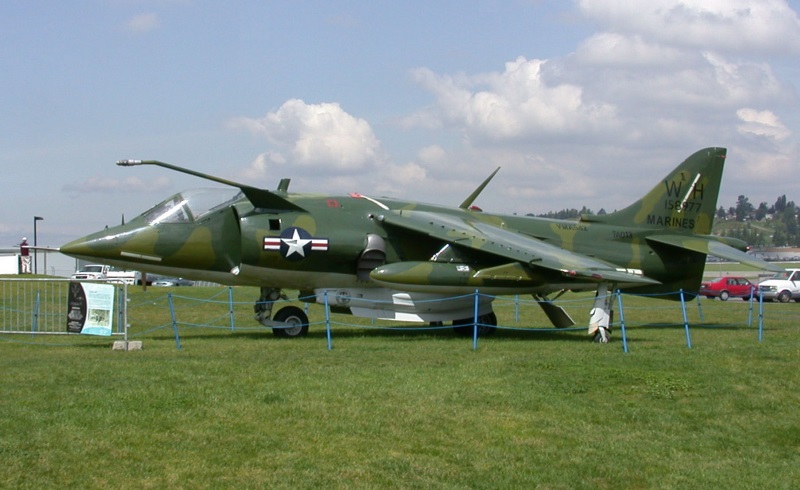
The changes included:
The side-mounted camera fitted in the AV-8A was deleted.
* In 1973, the Spanish Navy placed an order for 6 AV-8As and 2 TAV-8As for their naval air service, the "Arma Aerea de la Armada". They were given the US designation of "AV-8S" and "TAV-8S". BAE gave the AV-8S a designation of "Mark 53" and apparently referred to the TAV-8S as the "Mark 56". In Spanish Navy service they were designated the "VA-1" (single-seat) and "VAE-1" (tandem-seat) and officially known as "Matadors" -- though for some reason the pilots never liked or used the name. The Spanish bought five more AV-8S Harriers in 1980, and though these were little different from the first batch, for some reason BAE Systems assigned them a new designation of "Mark 55".
The order for the first batch was funneled through the US Navy, with assemblies shipped from Britain and put together by McDonnell Douglas, since Spain was under a Rightist government at the time and arm sales to them would have been embarrassing to the British government. The second batch was supplied directly, which was apparently the reason for the different mark number.
The Spanish Harriers were initially operated off land bases and the light carrier DEDALO, which had been built in 1943 as the "jeep" carrier USS CABOT. The DEDALO was an antique with a wooden deck, and metal sheathing had to be laid down on the rear of the deck to allow Harrier landings. The DEDALO was retired in 1988, to be replaced in service by the modern light carrier PRINCIPE DE ASTURIAS, which then became the "floating home" of the Spanish Harriers. The PRINCIPE DE ASTURIAS could accommodate 8 Harriers and 14 helicopters.
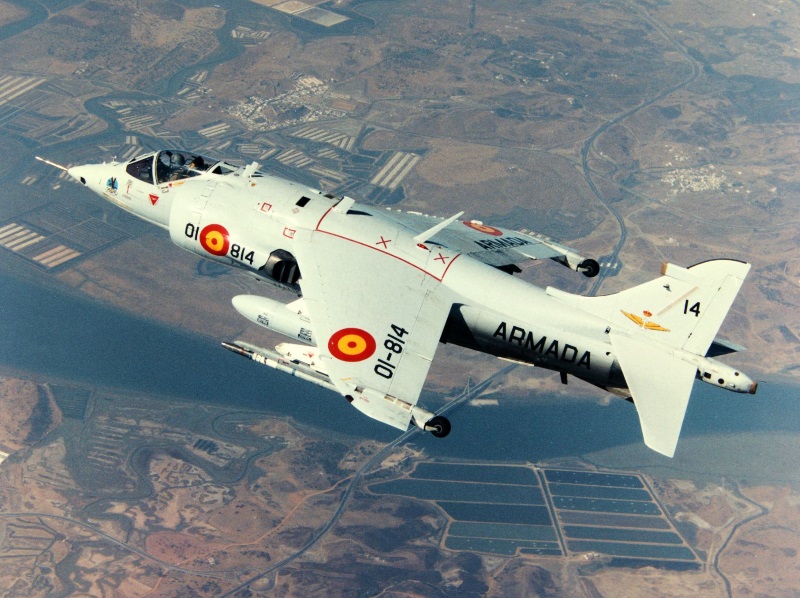
The Spanish Harriers were fitted with Marconi Sky Guardian RWRs beginning in 1987. The Sky Guardian, unlike the earlier Marconi ARI-18223 RWR, was not a simple radar detector, but could actually identify the type of threat by comparing the radar signal with a stored library of 200 radar signatures.
* The Spaniards really liked their Harriers and replaced them with the updated Harrier IIs in 1997, selling off the surviving 7 AV-8S and 2 TAV-8S to Thailand. The old aircraft were all refurbished by the Spanish CASA firm before delivery; the Thais disregarded the little-used Spanish name of "Matador", and referred to them as "Harriers". However, the Thais were never able to operate the complicated Harriers effectively, and finally withdrew them from service in 2006.
* The USMC's provision for Sidewinder missiles on the AV-8A led the service to devise an interesting new dogfighting tactic, named "vectoring in forward flight (VIFF)". Experiments performed by the USMC with VIFF demonstrated that it had some extraordinary qualities. The Marine pilot who performed the first evaluations on VIFF in 1970, Captain Harry Blot, fully reversed the nozzles while flying at high speed on his first test flight. He reported that he "decelerated rapidly" -- but he couldn't determine just how rapidly, since he was wrapped around the stick with his nose stuck on the gunsight.
Although the Harrier with its short wings had a poor turning radius, VIFF gave it some unusual maneuvering options, allowing it to perform strong banking turns, tight loops, and quick braking to allow a pursuer to overshoot. There was a lively debate over the merits of VIFF. It was clearly not a miraculous tactic, but the Marines were so impressed with it that they requested, and got, changes to the Pegasus engine to support it. The changes included strengthened nozzles, an uprated nozzle drive motor, and a capability to redline the engine for 2.5 minutes. The Marines established VIFF as an operational doctrine.
BACK_TO_TOP* The Royal Navy's waffling on the P.1154 quickly came back to haunt the service. In 1966, the British Labour government decided to give the axe to all of Her Majesty's fleet carriers; the Phantoms on which much money had been lavished now could only operate off of land bases. However, in 1968 the government decided that helicopter carriers were still affordable and useful, though they were given the entirely baffling name of "through-deck cruisers" for the sake of political correctness. Royal Navy jokers renamed them "see-through cruisers".
The Harrier was an obvious fit for such vessels. As noted, the P.1127 had operated off the deck of a carrier back in 1963, and during the 1960s and 1970s Harriers were flown without difficulty off a number of vessels, some of them very small. The desireability of a naval Harrier wasn't obvious to everyone, however; there was still the prejudice that Mach 2 was an absolute necessity, and the Harrier was only supersonic in a dive. Still, half a loaf was better than none, and in August 1972 -- after fanatical lobbying by concerned Royal Navy air staff to overcome a seemingly endless series of bureaucratic obstacles -- development was begun on a naval Harrier, to be derived in as minimal a fashion as possible from the GR.3, for operation off light carriers.
After further near-brushes with death, the first "P.1184 / Sea Harrier Fighter-Reconnaissance-Strike Mark 1 (FRS.1)" flew on 20 August 1978. It was very similar to a GR.3 from the air intakes back, but the cockpit and nose were largely redesigned.
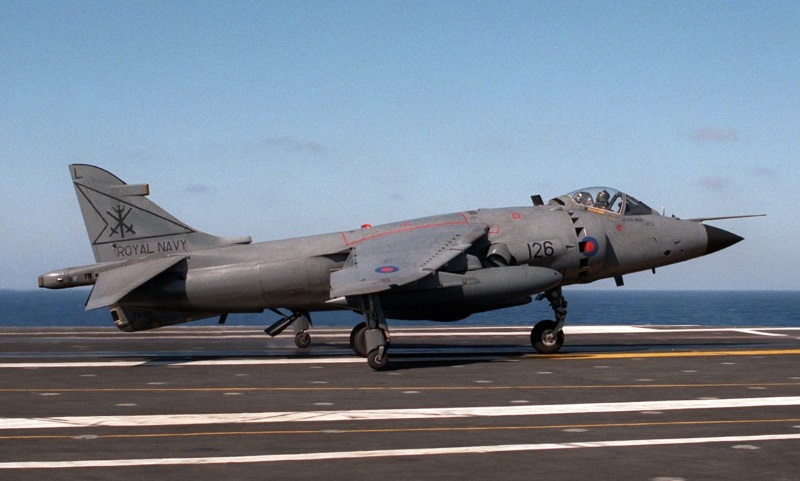
The Sea Harrier, as its "FRS" designation implied, was intended to be a multirole aircraft, suited for air combat, with the capability of carrying a Sidewinder on each outer wing pylon, as well as for attack and reconnaissance. Since its primary air adversary was expected to be Soviet Bear-class turboprop reconnaissance and missile-carrier aircraft, the Sea Harrier's subsonic speed was not regarded as a major limitation.
The mission did, however, require that an air-intercept radar be added, and the Ferranti "Blue Fox" radar was selected. The Blue Fox was a derivative of the "Sea Spray" radar developed for navalized Westland Lynx helicopters, and had four operational modes, including "Search", "Air-To-Air Attack", "Air-To-Surface Attack", and "Boresight". It was relatively simple compared to other contemporary fighter-aircraft radars, in particular lacking a look-down capability, but it was compact, light, affordable, and met mission requirements.
A new nav-attack kit was fitted as well, consisting of a Ferranti attitude reference and heading system, linked to a Decca 72 Doppler radar. The new system was provided because the Ferranti FE541 system used on the RAF Harriers had to be aligned while the aircraft was dead motionless on the ground, a difficult condition to achieve on an aircraft carrier on the open sea.
The pilot needed more display area on the control panel to deal with the new avionics. This demanded that the cockpit be raised 28 centimeters (11 inches). Raising the cockpit also fixed one of the major disadvantages of the GR.3 in air combat: the poor rearward and sideways view for the pilot. The Sea Harrier's canopy was bulged to improve the view forward and downward. The height of the tailfin was increased by 10 centimeters (4 inches) to compensate aerodynamically for the raised cockpit.
___________________________________________________________________
BAE SEA HARRIER FRS.1:
___________________________________________________________________
wingspan:
7.7 meters (25 feet 3 inches)
wing area:
18.67 sq_meters (201 sq_feet)
length:
14.5 meters (44 feet 7 inches)
height:
3.71 meters (12 feet 2 inches)
empty weight:
5,942 kilograms (13,100 pounds)
max loaded weight:
11,884 kilograms (26,200 pounds)
maximum speed:
1,190 KPH (740 MPH / 645 KT)
service ceiling:
15,000 meters (50,000 feet)
operational radius:
750 kilometers (465 MI / 405 NMI)
___________________________________________________________________
An improved autopilot was added to help the pilot deal with the increased workload. With all the new avionics, the cockpit of the Sea Harrier was an entire redesign of that of the GR.3. A new Martin-Baker Mark 10H zero-zero ejection seat was also added. Other minor changes were made:
For training, the Royal Navy initially obtained a single new-build T.4A, calling it a "T.4AN", and later obtained seven hand-me-down T.4As from the RAF, also redesignating them T.4ANs. The navy then acquired three new-build "T-4Ns", which were minor navalized modifications of the standard T.4, with the Pegasus 104 engine and a basic subset of FRS.1 avionics. Since the T.4Ns in particular lacked the Blue Fox radar of the FRS.1, the Royal Navy also obtained three Hawker Hunter T.8M trainers fitted with the Blue Fox as radar trainers. Two of the Hunter T.8Ms had been used in development of the radar.
The T.4N was combat-capable, but was too long to fit on the elevators on British carriers and could not be stowed below deck. The FRS.1 itself would fit on an elevator if its nose cone were hinged back.
* The first production FRS.1 was handed over to Royal Navy service in mid-June 1979. The Sea Harrier was a welcome arrival for the Royal Navy's combat aircraft pilots, since the RN's last fixed-wing combat aircraft, the BAE Buccaneer and their Spey-powered Phantoms, had been retired the previous December.
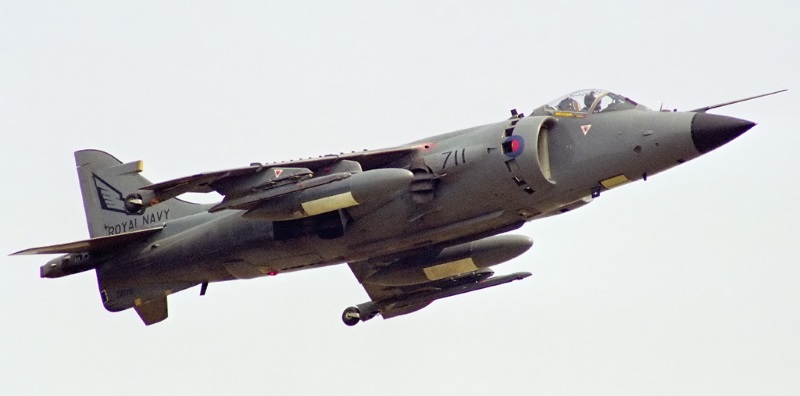
The Sea Harriers, or "Shars" as they were sometimes called, were slated for operations off the three "command cruisers" (as the "through-deck cruisers" had been somewhat more rationally renamed) HMS INVINCIBLE, ILLUSTRIOUS, and ARK ROYAL, the last of which was in planning at the time, with a normal complement of six Sea Harriers along with helicopters. Carrier operation of the Sea Harrier was greatly enhanced by an elegantly simple idea, devised by Royal Navy Lieutenant Commander Douglas Taylor: the ski-jump take-off ramp.
Taylor calculated that simply modifying the deck so that it curved up at the end would throw the fighter up into the air, allowing it to carry more warload with a shorter take-off run, as well as give a Royal Navy pilot more time to eject if it became apparent his aircraft was going to splash. Taylor proposed the idea in the early 1970s, but it wasn't until 1976 that Hawker received funding to perform land-based tests of the ski jump take-off. The tests clearly demonstrated the effectiveness of the concept. Resistance to the ski jump concept was so stubborn in some quarters that advocates of the idea collectively referred to the critics as the "Flat Deck Preservation Society". The advocates prevailed, and the ski jump was adopted for carrier operations. Ski jump take-offs were apparently very spectacular to watch, though pilots described them as "cake".
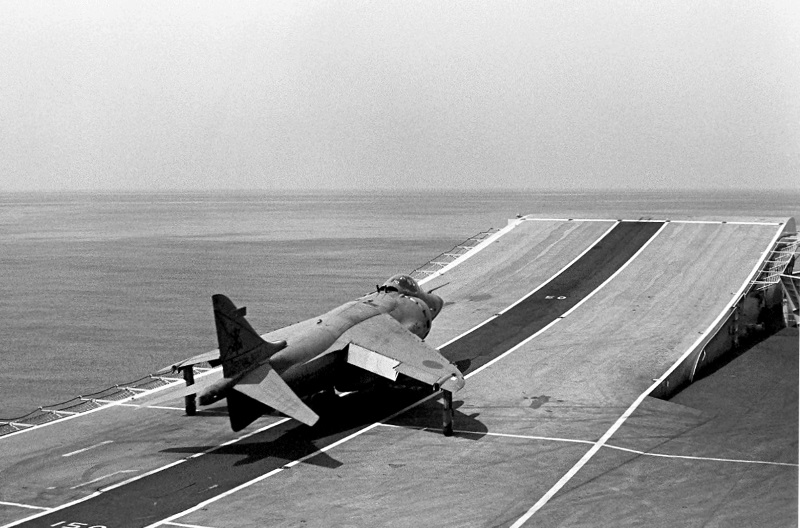
HMS INVINCIBLE and ILLUSTRIOUS were both originally fitted with a 7-degree ski jump, while the ARK ROYAL featured a 12-degree ski jump when it was commissioned in 1985. Both the INVINCIBLE and ILLUSTRIOUS were later refitted with a 13-degree ramp. The Spanish light carrier DEDALO was not fitted with a ski jump, but the modern Spanish PRINCIPE DE ASTURIAS and Thai CHAKRI NARUEBET both had 12-degree ski jumps.
BACK_TO_TOP* The Sea Harrier proved its worth not long after its operational introduction, when a tottering junta in Argentina seized the Falkland Islands in 1982. The British response in April 1982 was Operation CORPORATE, in which a naval force was assembled to carry out an amphibious landing on the islands. Air support was initially provided by 28 Sea Harriers operating off the command carriers HMS HERMES and HMS INVINCIBLE.
To provide more air power, on 3 May 1982, 14 Harrier GR.3s of the RAF Number 1 Squadron flew nonstop some 6,400 kilometers (4,000 miles) from the UK to Ascension Island in the South Atlantic. The Harriers made the trip in nine hours and refueled in mid-air five times.
Ascension was the most forward available base for CORPORATE, though it was almost exactly halfway between the UK and the Falklands, leaving the GR.3s another 6,400 kilometers from the combat zone. Most of the GR.3s made the rest of the trip on container ships and then jumped to the carriers, but four of them flew the rest of the way on their own.
The GR.3s were armed with SNEB rockets, BL755 cluster bombs, and laser-guided bombs for ground strikes. Although they didn't have a laser target designator themselves, they could hit targets designated by ground forces. The GR.3s were also hastily wired for Sidewinders and US-built Shrike anti-radar missiles, but didn't actually carry such weapons.
The Sea Harriers had been just as hastily fitted with countermeasures for air combat. A pair of chaff/flare dispensers were tacked on behind the underfuselage airbrake. This was done in such a hurry that the chaff-flare dispensers actually had to be air-dropped to the task force while it was underway by an RAF C-130 Hercules transport. In addition, an effort was made to cram the Marconi "Sky Shadow" jammer pod, used on the Tornado, into the shell of a 30-millimeter cannon pod, to be fitted in place of one of the guns. This improvisation was named the "Blue Eric" ECM pod and a small number were built, though it is unclear if they actually saw service in the Falklands campaign.
The Sea Harriers generally operated in the air defense role, while the GR.3s focused on ground attack. Since the GR.3's Ferranti FE541 nav-attack system could not be aligned on board ship, Sea Harriers accompanied GR.3s on strike missions to provide navigation until a land base was obtained. RAF GR.3 pilots were somewhat frustrated at being stuck with the "mudfighting" role. While they had never been trained for air-to-air combat, the fact that the opportunity was there made them feel like they were missing out on the glory. Three GR.3s were lost in combat to ground fire.
* Superficially, it might have seemed like the RAF had got the better part of the deal. The Sea Harriers operated under a number of disadvantages in air combat that on the face of things would have suggested they were outmatched:
However, Sea Harriers still scored 22 kills against Argentine aircraft, and also shot down a helicopter, with no air combat loss to themselves. Although the Argentines were operating at the limit of their combat radius, restricting their use of afterburner if they hoped to get back home, that was still an impressive achievement. The Sea Harriers were greatly aided in their success by the new third-generation AIM-9L Sidewinders they carried. The AIM-9Ls were "all-aspect" weapons, meaning they didn't have to be boresighted on the target's exhaust, and were much superior to earlier Sidewinder variants. They had been supplied in haste to the Royal Navy by the Americans when the war broke out.
Out of the 28 Sea Harriers used in the operation, six were lost. Two were shot down by Argentine ground fire; one was lost with its pilot in take-off; one simply fell off the deck while taxiing forward for take-off in icy conditions, with the pilot ejecting, to be picked out of the frigid sea; and two abruptly vanished without a trace in bad weather, apparently due to a mid-air collision. Over 2,000 sorties were flown, and aircraft availability was never less than 95% at the beginning of each day. Without the foresight of the naval planners who had stubbornly fought for the Sea Harrier, the Falklands might well have been given up to the Argentines without a fight.
* Aside from three prototypes, 54 FRS.1s were built up to 1988. In addition to the six lost in the Falklands, five more were lost in accidents. As discussed later, FRS.1s were given a modest set of updates during the 1980s.
The FRS.1 also served in the Balkan Wars, performing air patrols over Bosnia as part of international peace-keeping efforts -- beginning in early 1993 and continuing into the fall of 1995, when the FRS.1 went out of service. The aircraft carried new kit, including an improved IFF, expendable radar decoys that could be fired from the chaff-flare dispensers, a handheld Garmin 100 GPS navigation receiver mounted in the cockpit, and the latest AIM-9M Sidewinders.
One Sea Harrier was shot down on 16 April 1993. The pilot, Royal Navy Lieutenant Nick Richardson, ejected and was picked up by a British Special Air Service (SAS) rescue team. The SAS commandos led Richardson through enemy lines, and the group was then picked up by a French helicopter.
* In 1983:1984, India obtained a batch of six "Sea Harrier Mark 51s" and two tandem-seat "T.60s" for use off their carrier INS VIKRANT. The Mark 51s were basically FRS.1s, the differences being that they used a gaseous instead of a liquid oxygen system; had a modified radar system and Indian-specified radios and IFF; and were wired for the French Matra Magic missile, instead of the Sidewinder. The Mark 60s were essentially RAF T.4 trainers, with some minor changes in avionics.
Ten more Mark 51s plus a T.60 were ordered in 1985 and delivered in the 1989:1991 timeframe, with another batch of seven Mark 51s and a fourth T.60 obtained after that -- for a total of 23 Mark 51s and four T.60s. Two more T.60s, which were modified from RAF surplus T.4s, were obtained in the 1990s as attrition replacements, bringing that sum to 6.
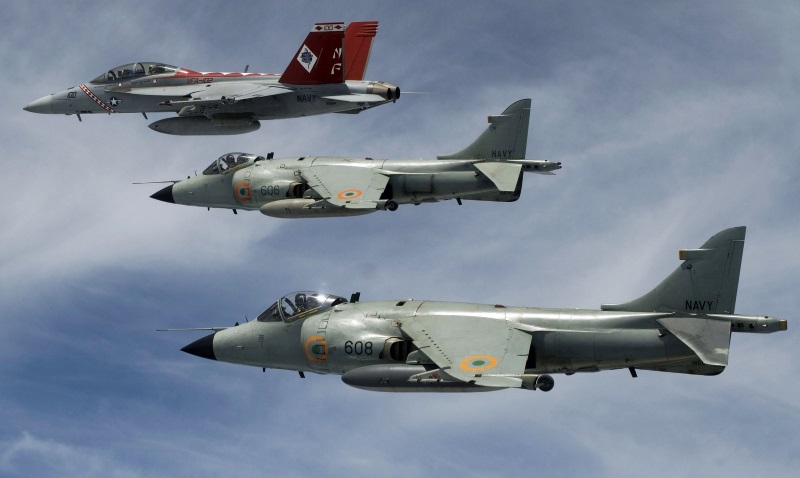
The Indian Sea Harriers operated off both the VIKRANT and the INS VIRAAT, previously the HMS HERMES. The VIKRANT was refitted with a 9.45-degree ski jump in 1991, which forced the retirement of the carrier's French Breguet Alize maritime patrol aircraft. The VIKRANT was retired in 1996 but the VIRAAT, with a 12-degree ski jump, remained in service. In 2005, after seeking funding for several years, the Indian Navy began a program to update 15 of their Mark 51s. The upgrade featured Israeli kit, including the Elta EL/M-2032 multimode radar, provisions for the Elbit DASH helmet-mounted sight, and carriage of the Rafael Derby BVR air-to-air missile. The VIRAAT was finally decommissioned in 2016, with the Indian Shar fleet then being retired. They were replaced by MiG-29K naval fighters, operating off the new carrier INS VIKRANT (2).
BACK_TO_TOP* Despite the success of the Sea Harrier in the Falklands, many Royal Navy officers realized they had been lucky, since the Shar had taken on a task it hadn't really been designed for, and much of the type's success was due to the highly effective AIM-9L missile. The war demonstrated specific deficiencies with the Sea Harrier: it couldn't stay in the air long enough; two Sidewinders weren't enough; the Sidewinder didn't have "stand-off" range; and, to no great surprise, the Blue Fox radar had not been quite up to the job, particularly because of its lack of "look down" capability.
An interim "Phase I Update" was implemented immediately after the war, with refits beginning in the summer of 1982 and ending in 1987. This involved two straightforward enhancements, in the form of a new 854-liter (225 US gallon) drop tank to replace the existing 455-liter (120 US gallon) drop tank, and a launch rack to allow carriage of two Sidewinders on each outer pylon, doubling the Sea Harrier's missile capacity to four.
Other small changes were added in the Phase I Update. One was a scheme known as "nozzle inching" or "nozzle nudging" that allowed a Sea Harrier pilot to perform limited adjustment of the nozzle position using the airbrake switch on top of the throttle, reducing the "three-hand" workload in STOVL flight. Although the technique only could change the nozzle position by a maximum of ten degrees, it proved very useful in allowing the pilot to fine-tune his flight condition. Another modification was the addition of an advanced instrument landing system designated "Microwave Aircraft Digital Guidance Equipment (MADGE)" to help in carrier landings in bad weather.
In addition, the FRS.1 was fitted with a backup power generator system. The pop-up ram-air turbine emergency power generator was deleted. It had always been a little dubious, since it was to be used if the engine flamed out. Any Shar pilot in his right mind who couldn't get a relight after a flameout would simply eject, since the idea of dead-stick landing a Sea Harrier, with its tiny wings and 3:1 glide slope, onto a carrier was absurd, and dicey even on a long shore-based strip.
One change had been in process before the Falklands War: fit and qualification of the Sea Harrier for launching the BAE "Sea Eagle" long-range turbojet-powered antiship missile. The Sea Eagle went into service in 1987. A Sea Harrier FRS.1 could carry two Sea Eagles. Although the FRS.1 didn't have the radar systems to perform its own targeting for the Sea Eagle, the aircraft could receive targeting cues from other platforms, such as a BAE Nimrod maritime patrol aircraft. The Sea Eagle was designed for open-ocean combat and was not suited to the "littoral" (offshore) naval warfare environment that came to be the norm in the 1990s, and so they were retired. The missile remains in service with India.
* The other limitations required more work, and a "Phase II Update" program to the existing FRS.1 fleet was put in motion in 1983, with a contract issued to BAE in 1985. The upgraded Sea Harrier, which was also the basis for new production, was designated the "Fighter Reconnaissance Strike Mark 2 (FRS.2)" and first flew on 19 September 1988. The FRS.2 began trials with an operational evaluation unit in the early summer of 1993, with the first one going to a full operational unit in September of that year.
The main enhancements were replacement of the Blue Fox radar with the Ferranti "Blue Vixen" radar, and the ability to carry up to four American "AIM-120 Advanced Medium Range Air to Air Missiles (AMRAAM)".
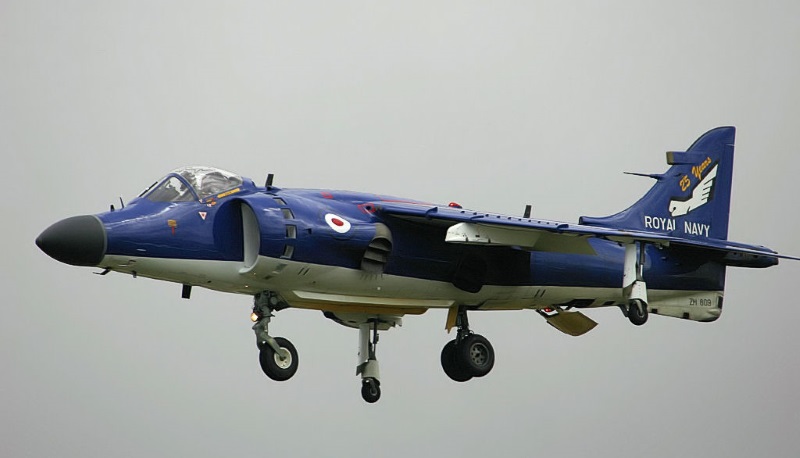
The Blue Vixen was far superior to the older Blue Fox, with 11 operating modes; greater range; a "look down" capability; a "track while scan" capability that allowed the radar to follow a target while scanning the sky for new targets; and some degree of "low probability of intercept (LPI)" capability that allowed the radar to detect targets without alerting the target's RWR. Blue Vixen was also much "smarter" and easier to operate than the Blue Fox, with one Sea Harrier pilot saying that with Blue Vixen performing an intercept was "down to selecting 'air to air', pointing the aircraft in roughly the right direction, and leaving the radar to it." It was regarded as a state of the art fighter radar.
AMRAAM is essentially a much-improved AIM-7 Sparrow derivative, with higher speed; a greater range of about 48 kilometers (30 miles); less smoke signature; and a fully-active radar guidance system that gives it a degree of "fire and forget" capability.
The Blue Vixen radar and the AMRAAM gave the FRS.2 a formidable capability to engage and destroy intruders at "beyond visual range (BVR)", and at relatively short ranges a Shar pilot could even fire all four missiles simultaneously to attack four separate targets. The FRS.2 was the first European aircraft to be qualified for the AMRAAM. While once Sea Harrier pilots felt themselves at a disadvantage against other modern fighters, the FRS.2 with its formidable armament and radar did much to level the playing field in air combat. The FRS.2 could carry two AMRAAMS on the outer pylons, and two on pylons attached to the belly in place of the cannon. In fact, the cannon were not generally fitted for most missions, though they still remained available when needed. Alternatively, the FRS.2 could carry two AMRAAMS and four Sidewinders.
Discounting the nose probe on the FRS.1 -- the probe was relocated to the tailfin on the FRS.2 -- the FRS.2 was about 35 centimeters (13.75 inches) longer than the FRS.1, to accommodate the new avionics and the new radar, which were housed in a distinctive longer and more cylindrical nose. Wingtip extensions were originally considered to compensate for the aerodynamic effects of carrying the AMRAAM, but proved unnecessary; however, minor aerodynamic changes to the wings were implemented. A new Pegasus variant, the "Pegasus 106", a rebuild and refinement of the navalized Pegasus 104, was fitted as the powerplant.
The cockpit was reworked (again) to provide such niceties as multi-function displays and a "hands on throttle and stick (HOTAS)" control system. A better nav/attack system was added, as well as the Marconi Sky Guardian RWR. The updated aircraft also featured a MIL-STD-1553B databus. GPS navigation capability was eventually added through the simple expedient of mounting a Garmin 100 handheld GPS receiver in the cockpit and wiring it to an antenna fitted behind the ejection seat.
33 FRS.1s were converted them to FRS.2 spec, with the last FRS.1 going in for conversion in 1995 and the final "rebuild" FRS.2 delivered in 1997. 18 new FRS.2s were ordered and delivered from 1995 into 1998, with the last of the batch, delivered on 24 December 1998 as a "Christmas present" to the Royal Navy, being the final "all British" Harrier built. It was photographed alongside one of the surviving P.1127s as a publicity stunt.
In addition, the Royal Navy obtained seven "T Mark 8" trainers, all of which were conversions from existing Royal Navy and RAF two-seaters. The T.8 was similar to the T.4N, but featured updated avionics and cockpit layout better matching the Sea Harrier FRS.2. The T.8 was not fitted with Blue Vixen radar. Initial flight of the first T.8 was in 1994 with initial delivery in 1995.
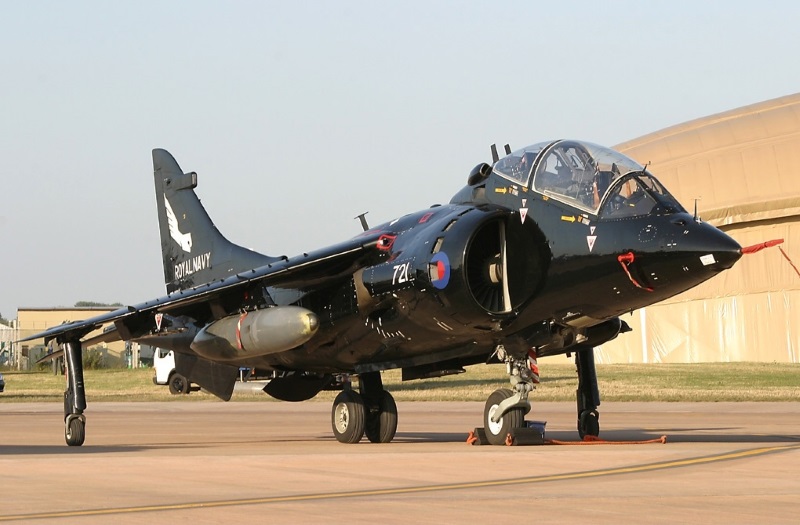
* The FRS.2 upgrade and procurement program gave the Royal Navy a respectable fleet of 51 Sea Harriers. The FRS-2 took the place of the FRS.1 in Balkan patrols, having begun operational evaluation flights there in 1994.
In the mid-1990s, the FRS.2 was redesignated the "FA.2" where "FA" stands for "Fighter Attack". The "R" for reconnaissance was dropped as the Sea Harrier had never really been used or fitted for that mission, the Royal Navy having never bothered to obtain a reconnaissance pod for the type. The "S" for "Strike" was changed to "A" for "Attack" apparently because the Sea Harrier's nuclear strike mission was mothballed in 1991 as part of the general drawdown of Western tactical nuclear forces. Actually, to be nitpicky about it, the original new designation was "F/A.2" but the "/" was dropped a year after the change, possibly because it aped American designation schemes too much.
Plans had been in place to keep the Sea Harrier in FAA service until 2012 at least, when the F-35B STOVL version of the Lockheed Martin "Joint Strike Fighter (JSF)" was expected to take over. Britain had been a major contributor to the JSF program, and saw it as the future. However, in early 2002 the Ministry of Defense stated that withdrawal would begin in 2004; the last Royal Navy Shars were withdrawn from frontline service in 2006.
One ended up in private hands, the buyer being an American real-estate magnate and pilot, to be refurbished for the airshow circuit. India considered buying up some surplus Royal Navy FA.2s, but the decision was made that refit and upgrade would be too expensive. Ironically, the F-35 program was delayed, leaving the FAA with a capability gap.
BACK_TO_TOP